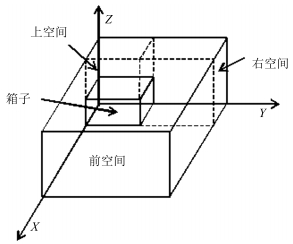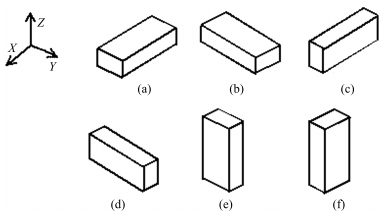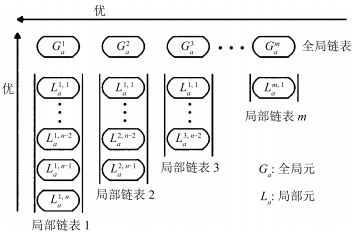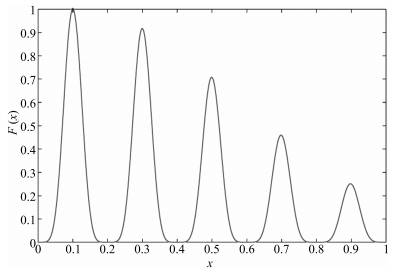Feature Selection Method Based on Maximum Information Coefficient and Approximate Markov Blanket
-
摘要: 最大信息系数(Maximum information coefficient,MIC)可以对变量间的线性和非线性关系,以及非函数依赖关系进行有效度量.本文首先根据最大信息系数理论,提出了一种评价各维特征间以及每维特征与类别间相关性的度量标准,然后提出了基于新度量标准的近似马尔科夫毯特征选择方法,删除冗余特征.在此基础上提出了基于特征排序和近似马尔科夫毯的两阶段特征选择方法,分别对特征的相关性和冗余性进行分析,选择有效的特征子集.在UCI和ASU上的多个公开数据集上的对比实验表明,本文提出的方法总体优于快速相关滤波(Fast correlation-based filter,FCBF)方法,与ReliefF,FAST,Lasso和RFS方法相比也具有优势.Abstract: Maximum information coefficient(MIC) is utilized to capture a wide range of associations between variables, including linear, non-linear and non-functional relationships. In this paper, firstly a measurement based on MIC is presented to measure relationships of features and classes in feature selection. Then the approximate Markov blanket with the proposed measurement is used to remove redundant features. A two-stage method based on feature ranking and approximate Markov blanket is further applied to select the feature subset by analyzing relevance and redundancy respectively. Experimental results on UCI and ASU open datasets show that the proposed method outperforms the fast correlation-based filter (FCBF) and gives better performance than ReliefF, FAST, Lasso and RFS.
-
装箱问题按照目标函数的不同类型分为容器装载问题、箱柜装载问题和背包装载问题[1].容器装载问题是将所有待装箱子装入一个不限尺寸的容器中, 在诸多方案中找到一个使容器体积最小的装载方案, 该类型问题一般规定容器的长和宽为常数, 高为变量; 箱柜装载问题是给定一些规格统一的方型容器和一些不同类型的方型箱子, 找到一个能把所有箱子装入最少容器中的装载方案; 背包装载问题是给定一个固定规格的容器和一些有一定价值的箱子, 然后将部分箱子装入容器中, 找到一个使得装入容器中箱子总价值最大的装载方案, 若将箱子的体积作为价值, 则背包装载问题就转换为找到一个如何使容器的填充率最大的装载方案.其中容器装载问题和箱柜装载问题具有一定的局限性, 限制了其工业领域的应用范围.因此本文从背包装载问题入手对三维装箱问题作初步研究.
装箱问题是传统的NP问题, 具有广泛的应用领域.随着当今世界信息技术、大数据、数据流、数据关系的分析处理的不断发展, 为装箱问题的应用拓展了新的领域, 例如信息网络、交通网和云存储等有限资源的最大利用率问题, 有限资金投资的收益率最大化问题, 以及大数据相对关系匹配度最大化问题等.如何提高容器的空间利用率, 是当代科学研究和实践中一个非常重要的课题.找到高利用率的装箱方案, 对节约天然资源, 降低企业成本, 提高企业利润, 有着十分积极的现实意义.
近年来, 国内外的学者们陆续提出了一些解决三维装箱问题的算法. Ngoi等[2]采用独特的空间表征技术求解装箱问题. Bischoff等提出了一种启发式算法, 同时给出了三维装箱问题的一些测试实例[3-4], 其中文献[3]根据层和条的选择策略, 提出了按层布局的贪婪算法. Sixt提出了基于元启发式的禁忌搜索和模拟退火算法[5]. Gehring等提出并行化的遗传算法, 该方法先对箱子进行一定的预处理, 再用遗传算法对箱子进行优化组合来获得装载方案[6]. Bortfeldt等提出了一种禁忌搜索算法, 但该种方法只适用于箱子种类较少的情况[7].接着, Bortfeldt等针对层的策略, 又提出一种混合遗传算法[8].同时期, 国内学者何大勇等提出了求解复杂集装箱装载问题的遗传算法[9].随后, Eley提出了基于"块"的算法[10], 在此基础上, Bortfeldt等也基于"块"的概念, 给出了并行禁忌搜索算法[11]. Moura等基于"剩余空间的概念", 提出了一个贪心随机自适应搜索算法(Greedy randomized adaptive search procedures, GRASP)[12].张德富等针对圆形的装箱问题提出了拟人退火算法[13], 随后, 又提出了三维装箱问题的组合启发式算法[14]. Parrenóo等在文献[12]的基础上往前发展了一步, 将GRASP做了改进, 取得了明显的装箱效果[15]. Huang等针对单一类型的装箱问题提出了一个有效的拟人型穴度算法[16].张德富等提出了混合模拟退火算法, 该方法首先将箱子生成复合块, 接着给出一个基于块装载的构造型启发式算法, 然后将该启发式算法和模拟退火算法相结合, 提出了一个有效求解三维装箱问题的混合模拟退火算法[17]. Fanslau等也基于复合块的概念, 设计了一个有效的启发式树状搜索算法[18].张德富等又在文献[17-18]的基础上设计了一个多层启发式搜索算法[19], 该算法是采用深度和宽度同时搜索的思想, 提出的多层搜索算法, 该算法用多层搜索思想来选择一个近似最优块进行装载, 然后逐步构造直到获得一个装载序列, 较之前的算法取得了很好的装载效果, 但随着箱子规模的增大, 该算法需要较长的计算时间.刘胜等提出的求解三维装箱问题的启发式正交二叉树搜索算法[20], 该装箱算法装箱效率较已有算法装箱效率有显著提高, 但是当箱子种类较少时, 该算法的优势不明显.当然, 还有一些学者也取得了很好的研究成果[21-28].
在很多实际工业应用中, 待装箱子具有规格多样性和数量不确定性等特点.因此本文结合最优化原理, 用多元优化算法(Multi-variant optimization algorithm, MOA)实现三维装箱问题的求解, 该算法的基本思想是随机放置、局部调整和逐步逼近.通过对BR1 $\sim$ BR10共1 000组实例的仿真测试, 取得明显的装箱效果, 证明了本文算法的有效性和可行性.
1. 问题描述
给定一个长$L$、宽$W$、高$H$的矩形容器$C$和$n$个矩形箱子.每个箱子$b_i $的长为$l_i$, 宽为$w_i$, 高为$h_i $, 体积为$v_i=l_i \times w_i \times h_i $, 容器$C$的体积$V=L\times W\times H$.该问题的目标为:在箱子没有溢出容器, 且满足方向性约束和稳定性约束的条件下使容器的填充率最大, 即要尽可能多地将箱子装入容器中.问题的目标函数为
$ fitiness=\max \frac{\sum v _i }{V} $
(1) 在实际装箱问题中, 一般会遇到3个著名的约束条件[18]:
约束1 (C1). 方向性约束.在许多应用场合下, 箱子的装载具有方向性约束.方向性约束即为箱子的长度边、宽度边和高度边是否可以与容器的高度边平行放置.若没有这个约束条件的问题, 在装箱过程中, 箱子的任意一条边都可以竖直放置.
约束2 (C2). 稳定性约束.在许多应用场合下, 像在物流和交通运输等领域中, 有时箱子在装载时必须满足稳定性约束.也就是说每个箱子在装载时要必须得到容器底部或是其他已经装载了的箱子的支撑.针对不同的应用情况, 稳定性约束有部分支撑约束和完全支撑约束.部分支撑约束是指被装载箱子的底部允许有部分悬空, 完全支撑约束是指被装载箱子的底部不允许有悬空的部分.
约束3 (C3). 完全切割约束.在切割时, 每一刀必须将材料完全分割成两个部分.例如在木材和石材等的切割应用中, 一般的切割机只能做到完全切割.
本文算法在装箱过程中, 箱子的放置方式只选择其中的几种, 即并不是箱子的每一条边都可以与容器的高度边平行放置, 这就保证了本文算法满足C1方向性约束, 箱子的放置方式见第2.3节述; 同时, 剩余空间的分割与合并方式保证了本文算法满足C2稳定性约束, 剩余空间的分割与合并方式见第2.2节和第2.4节.综上所述, 本文算法是基于C1和C2两个约束进行的.
2. 装箱准备
2.1 最优化原理
根据一类多阶段决策问题的特性, 由Bellman等提出了解决动态规划的"最优化原理", 作为整个过程的最优策略具有这样的性质:无论过去的状态和决策如何, 对当前决策形成的状态而言, 余下的所有状态必须构成最优策略.即若要解决某一个优化问题, 需要做出$n$个决策, 若这个决策序列是最优策略, 对于任何一个$i$, $1<i<n$, 不论前面的$i$个决策是如何, $i$决策以后的最优决策只取决于由前面决策所确定的当前的$i$状态, 即以后的决策也是最优的[29].
2.2 空间的划分
箱子的装载是在容器的剩余空间中进行的, 剩余空间是指容器中未被填充的空间.箱子理论上可以放在容器的任意位置, 但不能超出容器的容纳范围, 也不能与其他货物交迭放置.为了满足装箱问题的稳定性约束和保证每一个箱子装进容器之前, 剩余空间都是立方体空间, 本文选择将箱子从容器的原点坐标处开始放置, 并且箱子摆放时必须与坐标轴平行或正交, 不能斜放, 也不能悬浮放置.当第一个箱子装进容器后, 将剩余空间分割成相对于刚刚装入的箱子的前空间、右空间和上空间三个立方体空间, 如图 1所示.对每一个箱子装入容器后产生的剩余空间都严格做同样的分割处理.为了装箱的有效进行, 每装进一个箱子, 更新记录一次容器的剩余空间.
2.3 箱子的放置
假设箱子的摆放没有方向性约束C1, 则在装箱过程中, 箱子的任意一条边都可以竖直放置, 此时可以将箱子的摆放方式细分为6种: 1) $l$平行于$L$, $w$平行于$W$, $h$平行于$H$; 2) $w$平行于$L$, $l$平行于$W$, $h$平行于$H$; 3) $l$平行于$L$, $h$平行于$W$, $w$平行于$H$; 4) $h$平行于$L$, $l$平行于$W$, $w$平行于$H$; 5) $h$平行于$L$, $w$平行于$W$, $l$平行于$H$; 6) $w$平行于$L$, $h$平行于$W$, $l$平行于$H$.如图 2(a) $\sim$ 图 2(f)所示.如果箱子的摆放有方向性约束C1, 则根据具体的方向性约束来选择箱子的摆放方式.箱子放入容器时, 本文算法先选择摆放方式后选择放置空间.
2.4 剩余子空间的合并
随着装箱的不断进行, 剩余空间中可能会产生一些废弃空间, 废弃空间指的是装不下任何一个待装箱子的剩余子空间.要提高容器的利用率, 就要最大程度的使用废弃空间, 即要尽可能地将废弃空间变为可用空间, 唯一的办法就是将废弃空间与其他剩余子空间合并.空间合并需同时满足3个条件: 1)两个空间相邻; 2)两个空间底面同高; 3)两个空间合并后, 可用空间必须增大.在同时满足上述3个条件时, 根据两个相邻空间的相对位置, 将空间的合并方式分为左右合并和前后合并两种方式, 如图 3所示.
3. 多元优化算法
3.1 算法简述
多元优化算法(Multi-variant optimization algorithm, MOA)是基于全局和局部搜索交替进行的思想提出的一种全新的群智能算法, 该算法在问题的解空间中随机产生全局搜索元及相应的局部搜索元, 对解空间进行全面细致地搜索, 从而逐渐逼近全局最优解.算法基于计算机的数据结构, 构造多元化结构体, 结构体用于记忆并协调搜索信息、调动全局局部交替寻优、记忆寻优过程, 多次全局局部交叉搜索后, 获得全局最优解和多个次优解[30].
结构体是搜索元全局和局部交替寻优信息交流的平台, 是寻优过程记忆的载体.搜索元和结构体构成了MOA的基本框架[30].结构体是一种能够按照一定规则, 记忆协调搜索信息, 有固定结构的数据表, 如图 4所示.
结构体是用指针实现的二维有序链表, 由全局链表和局部链表组成.结构体中, 第一行为全局链表, 用于保存全局搜索元并记忆和共享全局信息; 每一列叫做局部链表, 用于保存各个局部解空间内的局部搜索元和记忆局部信息.
全局链表和局部链表都是以搜索元的适应度值为关键字(Key)的有序链表.全局链表中前端搜索元优于后端搜索元, 局部链表中上部搜索元优于下部搜索元.搜索元是结构体的组织细胞, 用于存放和接收寻优信息.搜索元具有进行全局探索和局部调整的功能.
全局搜索元${\pmb G_a }$(Global atom)是全局解空间内随机生成的一个解.一个$d$维全局元描述如下:
$ {\pmb G_a } =\left[{unifrnd(l_1, u_1 ), \cdots, unifrnd(l_d, u_d )} \right] $
(2) 式中, $l_i $和$u_i $分别为第$i$维待优化参数$x_i $的下限和上限, $unifrnd\left({l_i, u_i } \right)$为返回$l_i $和之间的一个随机数.
局部搜索元${\pmb L_a }$ (Local atom)是以某个全局元为中心的局部邻域内随机生成的一个解.以全局元${\pmb G_a }$为中心的局部搜索元描述如下:
$ {\pmb L_a }\! =G_a +\!\left[{unifrnd\left( {-r, r} \right), \cdots , unifrnd\left( {-r, r}\right)} \right] $
(3) 式中$r$为局部邻域半径, 决定了局部搜索的范围.
将全局链表记忆较优的全局元作为具有搜索价值的局部解空间的中心, 根据其所在全局链表中的位置共享该局部解空间在所有已经发现的具有搜索价值局部解空间中的优越程度:位置越靠前, 其所在区域越优.当局部搜索元发现优于全局元的解时, 局部链表记忆较优的局部元将取代全局元作为新的具有搜索价值的局部解空间的中心, 以分享局部搜索获得的信息.
为了更好地说明MOA的实现过程, 给出测试函数
$ \begin{eqnarray*} F(x)=&\ \exp \left(-2\log (2)\times \left(\frac{x-0. 1}{0.8}\right)^2\right)\times\nonumber\\ &\ \sin ^6(5\pi x), \qquad \qquad0\le x\le 1 \end{eqnarray*} $
(4) 在给定的区间$0\le x\le1$内, 用MOA求$F(x)$取最大值时对应的解, 寻优过程如图 5所示, 多个全局搜索元和对应的局部搜索元对解空间进行全面细致地搜索, 逐渐逼近最优解$x=0.1$, 搜索结果如图 6所示.
3.2 问题的解
针对待装箱子在实际应用中的复杂性和不确定性, 本文采用多元优化算法实现三维装箱问题, 基本思想是:
1) 随机放置:装入容器的箱子以及箱子的摆放方式均随机选择;
2) 局部调整:对装入容器的局部箱子按目标函数值作局部调整;
3) 逐步逼近:递推的局部随机放置与调整优化, 使目标函数值逐步逼近最优值.
在用MOA实现三维装箱问题的求解之前进行预处理:
1) 箱子编号:按自然数序列对待装箱子进行编号, 若待装箱子总数为$d$, 则所有待装箱子的编号为$1$, $2, \cdots, i, \cdots, d$.若箱子数量很庞大或不确定, 则可以省略这一步, 直接分批次装即可.
2) 箱子摆放方式编号:若没有方向性约束C1, 则待装箱子的摆放方式编号为: 1, 2, 3, 4, 5, 6, 这6种摆放方式分别代表第2.3节中描述的6种摆放方式; 若有方向性约束C1, 则根据具体的方向约束, 待装箱子的摆放方式编号为第2.3节中的一种或几种.
多元优化算法实现背包装载问题的具体步骤如下:
步骤1. 编码.编码是应用多元优化算法首先要解决的问题.根据不同研究对象的不同性质, 把一个问题的可行解从其解空间转换到多元优化算法能处理的搜索空间中.假设总共有$d$个待装的箱子, 则MOA结构体里一个全局搜索元的编码方式为, $a_i$是$1\, \sim\, d$之间的随机的且互不重复的整数, 表示箱子的序号, $i$表示箱子$a_i$装入容器的次序. $d$维的搜索元$P$由全局搜索元式(2)产生, 装箱问题中, 需要全局搜索, 同时对局部进行调整.
步骤2. 分批随机放置箱子.在实际应用中, 待装箱子的种类多样且数量庞大, 因此将待装箱子分几批次装入容器.首先取出${\pmb P}$中的前$n$个待装箱子, 即第一批次的装箱个数为$n$, 然后将此批次的箱子依次装入容器中, $n$的大小根据箱子的数量设置.每一个箱子装入容器时, 采取一种拟人的方法, 先随机放置, 再做逐步调整.具体如下:
步骤2.1. 首先随机选取一个可用空间即剩余空间, 然后随机选取一种货物即箱子的摆放方式, 最后按该种摆放方式将箱子装入选取好的剩余空间.
步骤2.2. 若该箱子无法以该种摆放方式装入剩余空间, 则从箱子剩下的几种摆放方式中再随机选取一种, 并判断是否可以装入剩余空间.如果可以, 则将箱子放入所选的剩余空间并记录箱子的摆放方式; 反之, 继续选取摆放方式, 直到将箱子放入剩余空间或已遍历完该箱子的所有摆放方式为止.
步骤2.3. 重复步骤2.1和步骤2.2, 直到将箱子放入剩余空间或遍历完所有的剩余空间为止.每装一个箱子, 更新记录一次容器的剩余空间, 若有废弃空间且满足合并的条件, 则将废弃空间与其相邻的剩余空间合并.
步骤2.4. 重复步骤2.1 $\sim$ 2.3, 直到无剩余空间可装载或这一批次的$n$个箱子全部装入为止.
步骤3. 调整优化.利用最优化原理调整优化容器的填充率.已有的决策序${\pmb D}_1=\left[{a_1, a_2, \cdots, a_n }\right]$不一定是最优的决策序列, 要使该序列为最优决策序列, 利用最优化原理逐步调整该序列, 直到得到一个满意的结果, 具体步骤如下:
步骤3.1. 在容器外未装的箱子集中随机抽取一个箱子及其对应的摆放方式.
步骤3.2. 将抽取的箱子的体积与$a_1$的体积相比较, 若抽取的箱子体积大于$a_1$的体积, 同时抽取的箱子能够放入$a_1$放进容器之前对应的剩余空间(指$a_1$被放入容器之前算法记录的剩余空间), 则用随机抽取的箱子替换$a_1$.反之, 若抽取的箱子的体积小于或等于$a_1$的体积, 或者抽取的箱子不能放入$a_1$放进容器之前对应的剩余空间, 则$a_1$不用被随机抽取的箱子替换.用同样的方法依次优化该批次装进容器的箱子, 得到新的装箱序列${\pmb D}_{2}=[a_1, a_2 $, $\cdots $, $a_n]$, ${\pmb D}_{2} $是${\pmb D}_1 $的优化序列.
步骤3.3. 将下一批箱子装入容器后, 按步骤3.1和步骤3.2中的方法对新装进容器的几个箱子进行调整优化.重复上述步骤, 直到待装箱子已装完或剩余空间全为废弃空间时, 即可获得一个潜在的装箱方案.由于局部调整后的每一个局部序列都是最优序列, 因此整个全局序列同样也是最优序列, 符合最优化原理.
步骤3.3. 逐次逼近, 渐近收敛装箱过程, 直到满意为止.
算法的伪代码如下:
Begin
设置全局元个数$m$; 每个全局元内部的局部元个数即分的批次数$bn$; 每个局部元的维度即每批次装箱的个数$bn_i$ $(1\le i\le bn$); 全局解空间的下限$l=1$和上限$u\!=\!sum_{\rm box}$, $sum_{\rm box} $为箱子总数; 最大循环次数$I_{\max} $; 最大适应度值(即最大填充率) $fitiness_{\max }$; 初始化适应度值$fitiness_{best} =0$, $K=0$.
While $K<I_{\max}$ & &
For $i=1:m {\%}$生成$m$个全局元
$G_a^i\leftarrow$根据式(2)生成$m$个全局搜索元
(令$G_a^i$内某一维度的元素为$G_a^{i, j}$, 则满足$1\le G_a ^{i, j}\le sum_{\rm box}$且 $(1\le k\le sum_{\rm box} )$)
End For
For $i=1:m$
For $j=1:bn$
$L_a ^{i, j}\leftarrow $由$G_a ^i$和$bn_i$产生局部元
对$L_a ^{i, j}$做调整优化
End For
End For
更新调整结构体信息, 适应度值越好的装箱方案越往结构体左边移
更新记录$fitiness_{\rm best} $
$K=K+1$
End While
End Begin
算法的时间复杂度分析.如算法的伪代码所示, 算法中最外层的While大循环内有两层并列的循环, 其中第一个For循环内的每一个全局元是一个随机生成的数组, 只需一个执行周期, 即生成每个全局元的时间复杂度为O$(1)$, 因此第一个For循环的时间复杂度为O$(m)$; 第二个循环内包含两层嵌套的For循环, 其中内层的For循环内的局部元生成的时间复杂度为O$(1)$, 由于对每一个局部元优化调整的次数即每批次装箱的个数与局部元的个数$bn$相互独立, 则内层For循环的时间复杂度为O, 因此第二个循环的时间复杂度为O$( m(sum_{\rm box}+ bn) )$; 再综合最外层While大循环的时间复杂度O$(K)$, 因此算法的时间复杂度的通式为O$(K(m+m(sum_{\rm box}+bn)))$.
由于算法中$fitiness_{\rm best}$的更新具有随机性, 在最好的情况下, 在$K=1$时, $fitiness_{\rm best}=fitiness_{\max } $, 此时算法的时间复杂度为${\rm O}(m$ $+$ $m(sum_{\rm box}+bn))$, 但发生这种情况的概率极小.在一般情况中, 只会不断趋近于$fitiness_{\max }$, 因此算法在一般情况下的时间复杂度为.
4. 实验测试
4.1 测试准备
为了证明本文算法的有效性和可行性, 用具体的三维装箱测试数据对算法做了大量测试.采用的测试数据来自文献[9], 测试了其中的BR1 $\sim$ BR10共1 000个实例, 这些数据可以从OR-Library网站下载.在BR1 $\sim$ BR10中, 每种类型有100组测试实例, 同时每种类型中箱子的类型数分别为3, 5, 8, 10, 12, 15, 20, 30, 40, 50, 箱子的多样性从弱到强, 从而能够更好地反映算法在不同多样性装箱问题中的应用情况.本文算法用Matlab实现, 实验程序运行在Intel Core (TM) i3-3240 CPU @ 3.40 GHz处理器上, 运行环境为Windows 7专业版.
4.2 测试过程
以BR1中第1组实例为例具体描述测试过程, 将该实例取名为BR1-1. 表 1为BR1-1的待装箱子的三维值及数量.
表 1 BR1-1待装箱子的三维值及数量Table 1 The specification and quantity of BR1-1长(cm) 宽(cm) 高(cm) 数量 108 76 30 40 110 43 25 33 92 81 55 39 1) 在测试之前的预处理
预处理1. 读取表 1数据.通过程序将表 1转换为具体的数据矩阵, 数据矩阵的每一行代表一种类型的箱子, 每一行的前三列分别代表箱子的长、宽、高的值, 最后一列代表该种类型箱子的数量.
预处理2. 对所有箱子按顺序编号.由表 1可知, BR1-1中共有112个箱子, 其中, 第1种类型有40个, 第2种类型有33个, 第3种类型有39个.因此第1种类型的箱子的编号为1 $\sim$ 40, 第2种类型的箱子的编号为41 $\sim$ 73, 第3种类型的箱子的编号为74 $\sim$ 112.
2) 以BR1-1为例的测试过程
步骤1. 编码.随机产生112个1 $\sim$ 112之间不重复的整数串, 如[91, 63, 3, 36, 18, 39, $\cdots, $ 52, 74, 10, 97, 2], 此整数串中的每一个整数与预处理2中的箱子的编号对应, 例如91代表 91号箱子.相当于把所有待装箱子打乱.
步骤2. 分批次装载箱子.根据待装箱子的总数设置装箱过程分几批次装载, 同时设定每一批次装多少个箱子.例如BR1-1有112个待装箱子, 装箱过程即可设置为分5批次装载, 第1批次装32个, 第2批次装27个, 第3批次装22个, 第4批次装17个, 第5批次装14个, 这些具体的数据只是某一次实验设置的结果, 并不是固定不变的.接着进行装箱过程, 先将在步骤1产生的箱子序列串中从91号开始的前32个箱子依次装入容器中, 每一个箱子装入容器之前更新记录一次当前的剩余空间, 若中间有装不下的箱子, 则取该箱子后面的箱子继续装, 直到已装入容器的个数达到设定的32个或者是剩余空间已装不下任何一个未被装的箱子为止, 此时将箱子分为已装箱子和未装箱子两部分.
步骤3. 调整优化.从未被装入容器的箱子中随机抽取一个如编号为10的箱子, 比较10号箱子与91号箱子的体积大小, 若10号箱子的体积小于91号箱子的体积, 则装入容器的箱子保持不动, 同时将10号箱子放回未被装入容器的箱子集中, 此时默认91号箱子作为第一个装入容器的最优态; 接着从剩下的未被装入容器的箱子中随机抽取一个如编号为97的箱子, 比较63号箱子与97号箱子的体积大小, 若97号箱子的体积大于63号箱子, 则此时判断若97号箱子是否能被63号箱子装入容器之前的剩余空间装下, 若能装下, 则将63号箱子替换成97号箱子作为第二装入容器的最优态, 63号箱子则放到未装的箱子集中.替换后及时更新剩余空间, 以便于下一个箱子正确地装入容器中.如上所述, 依次将第1批的32个箱子优化完后, 继续将第2批次的箱子装入容器中, 对第2批次装入的箱子也做同样的优化处理, 第3批、第4批和第5批亦然.
步骤4. 逐次逼近.经过5次的装载调整优化之后, 容器的填充率逐渐逼近上限100%. 表 2是某一次实验时容器填充率逐渐变化逼近的过程.整个装箱过程满足最不利原则.最不利原则是指:若最不利的情况也能满足问题的要求, 则其他情况必然满足问题的要求.
表 2 某次实验得到的填充率的变化关系表Table 2 The change table of filling rate obtained from an experiment批次 1/(调整优化后) 2/(调整优化后) 3/(调整优化后) 4/(调整优化后) 5/(调整优化后) 容器填充率 0.2749/(0.3591) 0.5495/(0.5968) 0.7324/(0.7936) 0.8926/(0.9065) 0.9625/(0.9625) 4.3 实验结果与分析
许多国内外的研究者对文献[3]中的测试数据做了一些测试, 本文对文献[18]提出的启发式树状搜索算法、文献[3]提出的按层布局的贪婪算法、文献[6]提出的并行遗传算法、文献[7]提出的禁忌搜索算法、文献[12]提出的贪心随机自适应搜索算法、文献[15]提出的改进的GRASP、文献[17]提出的混合模拟退火算法、文献[19]提出的多层启发式搜索算法、文献[24]提出的VNS算法和文献[25]提出的FDA算法等比较典型的算法得到的装箱效果进行比较分析, 这些算法的计算结果与用多元优化算法实现装箱问题的计算结果如表 3和表 4所示. 表 3是前500组实例的测试结果, 表 4是后500组实例的测试结果. 表 4中最后一列是每个算法针对装箱实例BR1 $\sim$ BR10取得的平均填充率.
表 3 各种算法的装箱效果比较(1 ~ 500组)Table 3 Comparison of packing effects of various (groups 1 ~ 500) algorithms测试实例 约束 填充率(%) BR1 BR2 BR3 BR4 BR5 箱子的种类数 3 5 8 10 12 H_BR[3] C1 and C2 83.79 84.44 83.94 83.71 83.80 GA_GB[6] C1 and C2 85.80 87.26 88.10 88.04 87.86 TS_BG[7] C1 and C2 87.81 89.40 90.48 90.63 90.73 GRASP[12] C1 93.52 93.77 93.58 93.05 92.34 Maximal-space[15] C1 93.85 94.22 94.25 94.09 93.87 HSA[17] C1 and C2 93.81 93.94 93.86 93.57 93.22 CLTRS[18] C1 95.05 95.43 95.47 95.18 95.00 C1 and C2 94.51 94.73 94.73 94.41 94.13 MLHS[19] C1 94.92 95.48 95.69 95.53 95.44 C1 and C2 94.49 94.89 95.20 94.94 94.78 VNS[24] C1 94.93 95.19 94.99 94.71 94.33 FDA[25] C1 92.92 93.93 93.71 93.68 93.73 MOA C1 and C2 95.62 94.68 94.41 94.23 94.03 表 4 各种算法的装箱效果比较(501 ~ 1 000)Table 4 Comparison of packing effects of various (groups 501 ~ 1 000) algorithms测试实例 约束 填充率(%) BR6 BR7 BR8 BR9 BR10 平均 箱子的种类数 15 20 30 40 50 H_BR[3] C1 and C2 82.44 82.01 80.10 78.03 76.53 81.88 GA_GB[6] C1 and C2 87.85 87.68 87.52 86.46 85.53 87.21 TS_BG[7] C1 and C2 92.72 90.65 87.11 85.76 84.73 89.00 GRASP[12] C1 91.72 90.55 86.13 85.08 84.21 90.40 Maximal-space[15] C1 93.52 92.94 91.02 90.46 89.87 92.81 HSA[17] C1 and C2 92.72 91.99 90.56 89.70 89.06 92.24 CLTRS[18] C1 94.79 94.24 93.70 93.44 93.09 94.54 C1 and C2 93.85 93.20 92.26 91.48 90.86 93.42 MLHS[19] C1 95.38 94.95 94.54 94.14 93.95 95.00 C1 and C2 94.55 93.95 93.12 92.48 91.83 94.02 VNS[24] C1 94.04 93.53 92.78 92.19 91.92 93.86 FDA[25] C1 93.63 93.14 92.92 92.49 92.24 93.23 MOA C1 and C2 94.56 93.27 93.09 91.52 91.00 93.64 从表 3和表 4中可以看出: 1)从横向数据来看, 针对每一种算法, 表 3的装箱效果明显优于表 4中的装箱效果, 且从相邻算例之间填充率的变化量来看, 表 3要小于表 4.不难看出是箱子种类数的不同造成这一现象. 表 3中箱子的种类数、相邻算例之间箱子种类数的变化量都小于表 4.箱子种类数很多即同类箱子的数量很少时, 装箱过程中立方体对齐的难度大大增加, 箱子与箱子中间产生的废弃空间就随之增多, 从而问题求解结果的优度呈单调递减的趋势, 这在一定程度上体现了三维装箱问题存在的一个难题:箱子的种类数越多, 即箱子的多样性越强, 问题的求解就越困难. 2)从具体的平均填充率数据来看, 在同时满足方向性约束C1和稳定性约束C2的情况下, 填充率最高的是由张德富等提出的多层启发式搜索算法MLHS的94.02 %, 第2是本文算法MOA的93.64 %, 第3是Fanslau等提出的启发式搜索算法CLTRS的93.42 %, 第4是由张德富等提出的混合模拟退火算法HAS的92.24 %, 第5为Bortfeldt等提出的禁忌搜索算法TS_BG的89.00 %, 第6为Gehring等提出的并行化遗传算法GA_GB的87.20 %, 第7是Bischoff等提出的按层布局的贪婪算法H_BR的81.88 %.因此从数据分析结果来看, 本文算法具有有效性和可行性.
表 5给出了本文算法对BR1 $\sim$ BR10测试时的具体细节. 表 5中从左起的第三列Minimum到最后一列Average分别表示本文算法在同一类型的100个测试实例的运行中记录下的最短运行时间、最长运行时间、平均运行时间、最小填充率、最大填充率和平均填充率, 这里的运行时间指程序的实际运行时间.
表 5 元优化算法实现三维装箱问题时的一些测试细节Table 5 Some test details of MOA for 3D packing problem测试实例 约束 运行时间(s) 填充率(%) Minimum Maximum Average Minimum Maximum Average BR1 3 1.83 114.66 28.84 91.04 98.31 95.62 BR2 5 2.41 57.89 26.78 89.18 97.23 94.68 BR3 8 3.42 191.23 86.35 90.60 96.97 94.41 BR4 10 1.26 274.91 105.67 88.82 96.04 94.23 BR5 12 7.50 219.01 110.63 89.17 97.45 94.03 BR6 15 5.83 495.02 265.74 87.36 96.56 94.56 BR7 20 14.61 811.50 384.38 5.82 95.44 93.27 BR8 30 30.82 1 312.80 560.21 84.61 95.17 93.09 BR9 40 33.40 1 798.75 866.08 84.69 94.07 91.52 BR10 50 54.52 2 401.94 1 380.62 82.27 93.84 91.00 Mean 19.30 15.56 767.77 381.53 87.36 96.11 93.64 从表 5可以看出, 1)算法最短运行时间与最长运行时间相差很大, 原因是本文算法具有较强的随机性; 2)随着箱子种类数的增加, 算法的运行时间近似呈单调递增的趋势, 这是由于箱子种类数越多, 在求解问题时, 箱子的组合情况越复杂, 要取得好的装箱效果就需付出较大的时间代价.
用多元优化算法实现三维装箱问题时, 经多批次随机放置和局部调整优化, 装箱结果逐步逼近全局最优解的过程如图 7所示.在实验过程中, 装箱的批次数和每批次的装箱个数等这些参数的设置与每一个算例的箱子总数紧密相关.针对1 000个算例, 经过测试, 得出装箱的批次数的取值范围为比较适中, 每批次的装箱个数呈缓慢递减的趋势.
本文主要验证MOA算法实现三维装箱问题的有效性和可行性, 进一步工作将对算法参数的设置做自适应讨论研究.
5. 结束语
三维装箱问题属于典型的NP难题, 本文采用多元优化算法求解, 具有随机放置、局部调整和逐步逼近三大特性.经过多次实验测试, 取得理想的装箱效果, 证明了多元优化算法实现三维装箱问题的有效性和可行性.由于本文采用的是分批次随机放置, 因此针对实际装箱问题中的复杂性和不确定性具有很好的优势.但是算法若要得到更高的装箱效果, 就要增大试验次数, 随之计算时间也会增大.同时, 分多少批次装载和每批次装多少个等这些参数的设置与对象紧紧相关, 不具有一般性.
-
表 1 UCI数据集
Table 1 UCI datasets
数据集 特征总数 样本数 类别数 Spambase 57 4 601 2 Arrhythmia 452 279 16 Dermatology 34 366 6 Colon 2 000 62 2 表 2 两种特征选择方法选择的特征数
Table 2 The number of selected features in FCBF-MIC and FCBF
数据集 特征总数 FBCF-MIC FCBF Spambase 57 7.2 16.8 Arrhythmia 279 7.2 12.2 Dermatology 34 18.2 12.6 Colon 2 000 12.8 21 表 3 两种特征选择方法在UCI数据集上的实验结果(均值 $\pm$ 标准差%)
Table 3 The comparison of two feature selection methods on UCI datasets (Mean $\pm$ Std%)
数据集 NB 3NN SVM Full set NB FCBF-MIC FCBF Full set 3NN FCBF-MIC FCBF Full set SVM FCBF-MIC FCBF Spambase 79.93±0.30 86.93±2.15 78.60±2.34 87.55±1.47 89.43±0.51 87.8±2.05 90.11±0.62 90.15±0.98 90.24±0.88 Arrhythmia 61.17±3.81 62.66±3.91 65.84±3.83 57.5±3.72 65.04±4.62 62.13±3.96 61.87±3.98 65.49±3.64 64.07±3.33 Dermatology 96.06±1.00 97.16±1.27 96.27±0.91 95.08±1.51 95.63±0.84 95.52±0.64 96.61±1.27 96.83±0.40 95.85±0.74 Colon 80.00±3.76 83.02±2.89 83.06±3.29 78.07±4.56 77.42±5.67 76.87±3.08 78.71±3.29 83.87±2.04 83.23±3.76 Average 79.29 82.44 80.94 79.55 81.69 80.94 81.83 83.91 82.74 表 4 ASU数据集
Table 4 ASU datasets
数据集 特征总数 样本数 类别数 SMK-CAN 19 993 187 2 TOX-171 5 748 171 4 PIE10P 2 420 210 10 ORL10P 10 304 100 10 表 5 六种特征选择方法在NB上的比较(均值 $\pm$ 标准差%)
Table 5 The comparison of six feature selection methods on NB classification (Mean $\pm$ Std%)
数据集 FCBF-MIC FCBF ReliefF FAST Lasso RFS SMK-CAN 70.66±1.56 65.19±3.53 62.21±3.49 64.9±3.74 68.12±1.88 68.67±2.36 TOX-171 67.61±3.48 65.95 5.37 57.53±4.00 63.21±2.50 66.34±3.09 66.11±3.13 PIE10P 92.11±2.33 87.58±3.92 92.46±3.12 93.14±3.01 84.22±1.42 84.71±3.11 ORL10P 73.84±3.48 73.76±3.78 70.32±3.12 82.61±2.89 67.89±3.72 75.03±3.61 Average 76.06 73.12 70.63 75.97 71.64 73.63 表 6 六种特征选择方法在3NN上的比较(均值 $\pm$ 标准差%)
Table 6 The comparison of six feature selection methods on 3NN classification (Mean $\pm$ Std%)
数据集 FCBF-MIC FCBF ReliefF FAST Lasso RFS SMK-CAN 62.79±2.36 61.14±1.91 62.39±1.13 62.77±2.01 62.60±3.03 62.66±2.63 TOX-171 69.25±2.02 69.49±2.82 60.51±3.11 64.55±3.17 67.31±3.09 69.32±3.19 PIE10P 95.77±1.19 94.86±1.15 95.12±1.71 94.89±1.21 90.11±2.78 92.97±1.61 ORL10P 88.88±3.06 90.16±1.78 83.76±3.49 90.34±2.65 82.22±3.95 87.94±3.07 Average 79.17 78.91 78.14 75.45 75.56 78.22 表 7 六种特征选择方法在SVM上的比较(均值 $\pm$ 标准差%)
Table 7 The comparison of six feature selection methods on SVM classification (Mean $\pm$ Std%)
数据集 FCBF-MIC FCBF ReliefF FAST Lasso RFS SMK-CAN 68.28±1.60 65.26±2.31 67.27±1.33 68.04±1.47 67.81±1.54 68.04±1.78 TOX-171 69.26±2.13 69.44±5.35 61.76±1.19 65.16±3.33 69.30±2.12 70.12±3.31 PIE10P 97.56±1.24 95.35±0.51 95.21±0.97 96.38 1.56 95.27±1.17 95.58±1.21 ORL10P 82.08±5.32 76.08±2.66 75.24±2.46 81.84±3.01 78.80±5.55 82.56±4.60 Average 79.30 76.62 74.87 77.86 77.79 79.08 -
[1] Koller D, Sahami M. Toward optimal feature selection. In: Proceedings of the 13th International Conference on Machine Learning. Bari, Italy: Morgan Kaufmann, 1996. 284-292 [2] Liu H, Motoda H. Feature Selection for Knowledge Discovery and Data Mining. Berlin: Springer Science and Business Media, 2012. 1-5 [3] Bolón-Canedo V, Sánchez-Maroňo N, Alonso-Betanzos A. A review of feature selection methods on synthetic data. Knowledge and Information Systems, 2013, 34(3): 483-519 doi: 10.1007/s10115-012-0487-8 [4] 崔潇潇, 王贵锦, 林行刚.基于Adaboost权值更新以及K-L距离的特征选择算法.自动化学报, 2009, 35(5): 462-468 http://www.aas.net.cn/CN/abstract/abstract13753.shtmlCui Xiao-Xiao, Wang Gui-Jin, Lin Xing-Gang. Feature selection based on weight updating and K-L distance. Acta Automatica Sinica, 2009, 35(5): 462-468 http://www.aas.net.cn/CN/abstract/abstract13753.shtml [5] Yu L, Liu H. Feature selection for high-dimensional data: a fast correlation-based filter solution. In: Proceedings of the 20th International Conferences on Machine Learning. Washington DC, USA: AAAI Press, 2003. 856-863 [6] Lazar C, Taminau J, Meganck S, Steenhoff D, Coletta A, Molter C, de Schaetzen V, Duque R, Bersini H, Nowe A. A survey on filter techniques for feature selection in gene expression microarray analysis. IEEE/ACM Transactions on Computational Biology and Bioinformatics, 2012, 9(4): 1106-1119 doi: 10.1109/TCBB.2012.33 [7] 刘建伟, 李双成, 罗雄麟. p范数正则化支持向量机分类算法.自动化学报, 2012, 38(1): 76-87 http://www.aas.net.cn/CN/abstract/abstract17657.shtmlLiu Jian-Wei, Li Shuang-Cheng, Luo Xiong-Lin. Classification algorithm of support vector machine via p-norm regularization. Acta Automatica Sinica, 2012, 38(1): 76-87 http://www.aas.net.cn/CN/abstract/abstract17657.shtml [8] Li Z C, Liu J, Yang Y, Zhou X F, Lu H Q. Clustering-guided sparse structural learning for unsupervised feature selection. IEEE Transactions on Knowledge and Data Engineering, 2014, 26(9): 2138-2150 doi: 10.1109/TKDE.2013.65 [9] 刘峤, 秦志光, 陈伟, 张凤荔.基于零范数特征选择的支持向量机模型.自动化学报, 2011, 37(2): 252-256 http://www.aas.net.cn/CN/abstract/abstract17388.shtmlLiu Qiao, Qin Zhi-Guang, Chen Wei, Zhang Feng-Li. Zero-norm penalized feature selection support vector machine. Acta Automatica Sinica, 2011, 37(2): 252-256 http://www.aas.net.cn/CN/abstract/abstract17388.shtml [10] Gheyas I A, Smith L S. Feature subset selection in large dimensionality domains. Pattern Recognition, 2010, 43(1): 5-13 doi: 10.1016/j.patcog.2009.06.009 [11] Feng D C, Chen F, Xu W L. Detecting local manifold structure for unsupervised feature selection. Acta Automatica Sinica, 2014, 40(10): 2253-2261 doi: 10.1016/S1874-1029(14)60362-1 [12] Livni R, Lehavi D, Schein S, Nachlieli H. Vanishing component analysis. In: Proceedings of the 30th International Conference on Machine Learning. Atlanta, USA: Microtome Publishing, 2013. 597-605 [13] Liu H W, Sun J G, Liu L, Zhang H J. Feature selection with dynamic mutual information. Pattern Recognition, 2009, 42(7): 1330-1339 doi: 10.1016/j.patcog.2008.10.028 [14] Estévez P, Tesmer M, Perez C A, Zurada J M. Normalized mutual information feature selection. IEEE Transactions on Neural Networks, 2009, 20(2): 189-201 doi: 10.1109/TNN.2008.2005601 [15] Dash M, Liu H. Feature selection for classification. Intelligent Data Analysis, 1997, 1(1-4): 131-156 doi: 10.1016/S1088-467X(97)00008-5 [16] Kononenko I. Estimating attributes: analysis and extensions of RELIEF. In: Proceedings of the 1994 European Conference on Machine Learning. Berlin, Germany: Springer, 1994. 171-182 [17] Mitra P, Murthy C A, Pal S K. Unsupervised feature selection using feature similarity. IEEE Transactions on Pattern Analysis and Machine Intelligence, 2002, 24(3): 301-312 doi: 10.1109/34.990133 [18] Yang Y M, Pedersen J O. A comparative study on feature selection in text categorization. In: Proceedings of the 14th International Conference on Machine Learning. Nashville, Tennessee, USA: Morgan Kaufmann, 1997. 412-420 [19] Xing E P, Jordan M I, Karp R M. Feature selection for high-dimensional genomic microarray data. In: Proceedings of the 18th International Conference on Machine Learning. Williams College, Williamstown, MA, USA: Morgan Kaufmann, 2001. 601-608 [20] Yu L, Liu H. Efficient feature selection via analysis of relevance and redundancy. The Journal of Machine Learning Research, 2004, 5: 1205-1224 http://citeseer.ist.psu.edu/viewdoc/summary?doi=10.1.1.71.5055 [21] Reshef D N, Reshef Y A, Finucane H K, Grossman S R, McVean G, Turnbaugh P J, Lander E S, Mitzenmacher M, Sabeti P C. Detecting novel associations in large data sets. Science, 2011, 334(6062): 1518-1524 doi: 10.1126/science.1205438 [22] Kira K, Rendell L A. The feature selection problem: traditional methods and a new algorithm. In: Proceedings of the 10th National Conference on Artificial Intelligence. Massachusetts, USA: AAAI Press, 1992. 129-134 [23] Forman G. An extensive empirical study of feature selection metrics for text classification. The Journal of Machine Learning Research, 2003, 3: 1289-1305 http://www.citeulike.org/user/markymaypo/article/1915886 [24] Fleuret F. Fast binary feature selection with conditional mutual information. The Journal of Machine Learning Research, 2004, 5: 1531-1555 https://www.researchgate.net/publication/220320537_Fast_Binary_Feature_Selection_with_Conditional_Mutual_Information [25] Yu L, Liu H. Redundancy based feature selection for microarray data. In: Proceedings of the 10th ACM SIGKDD International Conference on Knowledge Discovery and Data Mining. New York, USA: ACM, 2004. 737-742 [26] Hall M A. Correlation-based feature selection for discrete and numeric class machine learning. In: Proceedings of the 17th International Conference on Machine Learning. Stanford, USA: Morgan Kaufmann, 2000. 359-366 [27] Ding C, Peng H C. Minimum redundancy feature selection from microarray gene expression data. Journal of Bioinformatics and Computational Biology, 2005, 3(2): 185-205 doi: 10.1142/S0219720005001004 [28] Peng H C, Long F H, Ding C. Feature selection based on mutual information criteria of max-dependency, max-relevance, and min-redundancy. IEEE Transactions on Pattern Analysis and Machine Intelligence, 2005, 27(8): 1226-1238 doi: 10.1109/TPAMI.2005.159 [29] Seth S, Principe J C. Variable selection: a statistical dependence perspective. In: Proceedings of the 9th International Conference on Machine Learning and Applications. Washington DC, USA: IEEE, 2010. 931-936 [30] Vergara J R, Estévez P A. A review of feature selection methods based on mutual information. Neural Computing and Applications, 2014, 24(1): 175-186 doi: 10.1007/s00521-013-1368-0 [31] 崔自峰, 徐宝文, 张卫丰, 徐峻岭.一种近似Markov Blanket最优特征选择算法.计算机学报, 2007, 30(12): 2074-2081 doi: 10.3321/j.issn:0254-4164.2007.12.002Cui Zi-Feng, Xu Bao-Wen, Zhang Wei-Feng, Xu Jun-Ling. An approximate Markov blanket feature selection algorithm. Chinese Journal of Computers, 2007, 30(12): 2074-2081 doi: 10.3321/j.issn:0254-4164.2007.12.002 [32] Saeed M. Bernoulli mixture models for Markov blanket filtering and classification. In: Proceedings of the 2008 IEEE World Congress on Computational Intelligence. Hong Kong, China: IEEE, 2008. 77-91 [33] Zhang Y, Ding C, Li T. A two-stage gene selection algorithm by combining ReliefF and mRMR. In: Proceedings of the 7th IEEE International Conference on Bioinformatics and Bioengineering. Massachusetts, USA: IEEE, 2007. 164-171 [34] Javed K, Babri H A, Saeed M. Feature selection based on class-dependent densities for high-dimensional binary data. IEEE Transactions on Knowledge and Data Engineering, 2012, 24(3): 465-477 doi: 10.1109/TKDE.2010.263 [35] Song Q B, Ni J J, Wang G T. A fast clustering-based feature subset selection algorithm for high-dimensional data. IEEE Transactions on Knowledge and Data Engineering, 2013, 25(1): 1-14 doi: 10.1109/TKDE.2011.181 [36] Ruiz R, Riquelme J C, Aguilar-Ruiz J S. Incremental wrapper-based gene selection from microarray data for cancer classification. Pattern Recognition, 2006, 39(12): 2383-2392 doi: 10.1016/j.patcog.2005.11.001 [37] de Souza R S, Maio U, Biffi V, Ciardi B. Robust PCA and MIC statistics of baryons in early minihaloes. Monthly Notices of the Royal Astronomical Society, 2013, 440(1): 240-248 http://adsabs.harvard.edu/abs/2014MNRAS.440..240D [38] Liu H M, Rao N, Yang D, Yang L, Li Y, Ou F. A novel method for identifying SNP disease association based on maximal information coefficient. Genetics and Molecular Research, 2014, 13(4): 10863-10877 doi: 10.4238/2014.December.19.7 [39] Mani-Varnosfaderani A, Ghaemmaghami M. Assessment of the orthogonality in two-dimensional separation systems using criteria defined by the maximal information coefficient. Journal of Chromatography A, 2015, 1415: 108-114 doi: 10.1016/j.chroma.2015.08.049 [40] Fayyad U M, Irani K B. Multi-interval discretization of continuous-valued attributes for classification learning. In: Proceedings of the 13th International Joint Conference on Artificial Intelligence. Chambéry, France: Springer, 1993. 1022-1027 [41] Lichman M. UCI machine learning repository [Online], available: http://archive.ics.uci.edu/ml, November 10, 2015 [42] Zhao Z, Morstatter F, Sharma S, Alelyani S, Anand A, Liu H. Advancing feature selection research. ASU Feature Selection Repository, 2010. 1-28 [43] Tibshirani R. Regression shrinkage and selection via the lasso. Journal of the Royal Statistical Society. Series B (Methodological), 1996, 58(1): 267-288 http://www.ams.org/mathscinet-getitem?mr=1379242 [44] Nie F P, Huang H, Cai X, Ding C. Efficient and robust feature selection via joint l2, 1-norms minimization. In: Advances in Neural Information Processing Systems 23: 24th Annual Conference on Neural Information Processing Systems. Vancouver, British Columbia, Canada: NIPS, 2010. 1813-1821 [45] 段洁, 胡清华, 张灵均, 钱宇华, 李德玉.基于邻域粗糙集的多标记分类特征选择算法.计算机研究与发展, 2015, 52(1): 56-65 doi: 10.7544/issn1000-1239.2015.20140544Duan Jie, Hu Qing-Hua, Zhang Ling-Jun, Qian Yu-Hua, Li De-Yu. Feature selection for multi-label classification based on neighborhood rough sets. Journal of Computer Research and Development, 2015, 52(1): 56-65 doi: 10.7544/issn1000-1239.2015.20140544 [46] Hall M, Frank E, Holmes G. The WEKA data mining software: an update. ACM SIGKDD Explorations Newsletter, 2009, 11(1): 10-18 doi: 10.1145/1656274 期刊类型引用(1)
1. 张博,裴宇驰,黄慧敏. 基于多模板匹配的双模型自适应相关滤波跟踪算法. 太赫兹科学与电子信息学报. 2022(06): 618-625 .  百度学术
百度学术其他类型引用(6)
-






 下载:
下载:







 下载:
下载:




